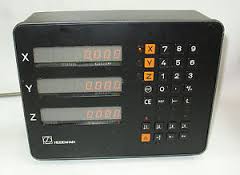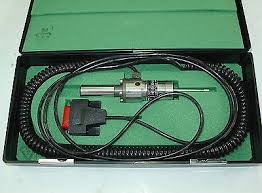Once
you start milling you soon realize all work has to be referenced,
easily done with a round bar with known diameter, but a lot of
calculating with manual dials.
Mechanical devices like wiggler are easy to build but only work in 2D and can not interface to the DRO.
My mill came with a Heidenhain DRO VRS 760b.

Not
sure when they where manufactured, but it looks massive, stuffed with
electronic components dating back to the late 1970's. Old but quite
advanced for the its age, it supports an edge finder (kanten taster)
KT120, terminating in a connector resembling a game port DA-15.

The idea was to start with what else than a google search on "3d touch probe diy" ...
https://www.google.com/patents/US5657549
https://www.google.com/patents/US5365673
https://www.google.com/patents/US5509211
http://www.homemetalshopclub.org/news/12/presentation_1202.pdf
http://fadedbits.com/2011/02/touchprobe/
many
reads further I discovered most design's are based on a lapsed patent
with three ball contacts connected in series. Soon I discovered this is
quite inaccurate, and my precision OCD kicked in, there has to be a
better way in using electronics to accurately measure this. The problem
with the three contact points is depending on the angle of attack, the
displacement until contact breaks is different.
My
thinking is along the lines of amplifying the movement/acceleration
with mechanical advantage, and measure with MEMS, optical, capacities or
inductive.
Requirements:
- Repeatability is more important than Accuracy of measurement.
- approach angle should not matter
- battery powered
- wireless
- LCD/led indicator, indicate power on and edge detected, if more accurate measuring is possible indicate measurement.
Evaluation:
- 3-Axis Gyro/Accelerometer ICAccuracy of less than 0.5 deg possible, https://electronics.stackexchange.com/questions/33374/choosing-an-accelerometer
- tan
0,5 deg = 0.00872686779 , this is a minute displacement, worth
investigating further. how will noise influence repeat ability?
- tan
0,5 deg = 0.00872686779 , this is a minute displacement, worth
investigating further. how will noise influence repeat ability?
- Opto reflective sensor
- displacement of 1mm easy to measure
- further testing required to establish repeatability
My Design
The body is fixed to the spindle, is houses a moveable part, which pivots on a spherical ball in the center, which locates in a tight fitting sleeve, this facilitates the measurement of small variances in horizontal and vertical plane.


No comments:
Post a Comment